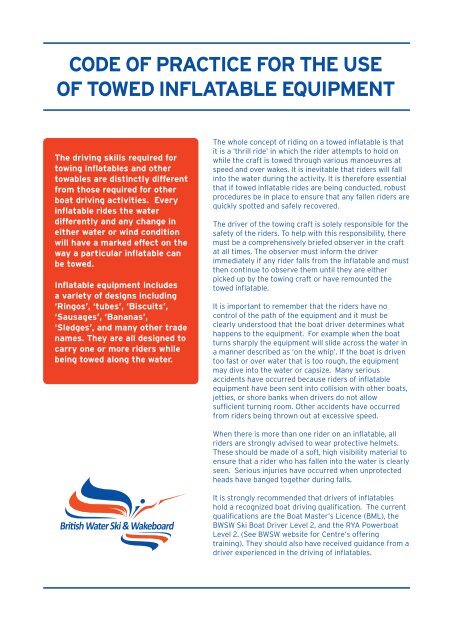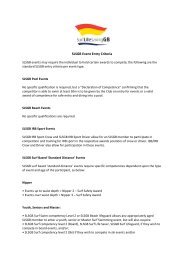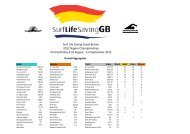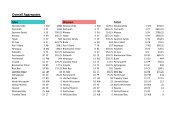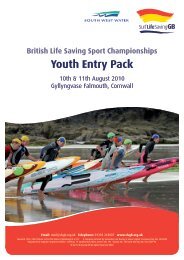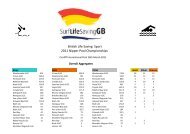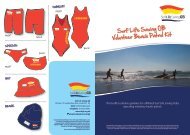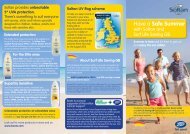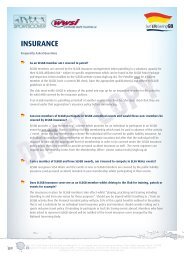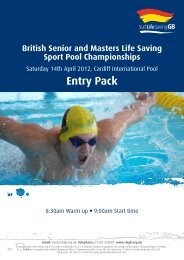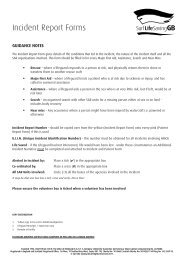BWSW Inflatable Recommendations:Layout 1 - SLSGB
BWSW Inflatable Recommendations:Layout 1 - SLSGB
BWSW Inflatable Recommendations:Layout 1 - SLSGB
Create successful ePaper yourself
Turn your PDF publications into a flip-book with our unique Google optimized e-Paper software.
CODE OF PRACTICE FOR THE USE<br />
OF TOWED INFLATABLE EQUIPMENT<br />
The driving skills required for<br />
towing inflatables and other<br />
towables are distinctly different<br />
from those required for other<br />
boat driving activities. Every<br />
inflatable rides the water<br />
differently and any change in<br />
either water or wind condition<br />
will have a marked effect on the<br />
way a particular inflatable can<br />
be towed.<br />
<strong>Inflatable</strong> equipment includes<br />
a variety of designs including<br />
‘Ringos’, ‘tubes’, ‘Biscuits’,<br />
‘Sausages’, ‘Bananas’,<br />
‘Sledges’, and many other trade<br />
names. They are all designed to<br />
carry one or more riders while<br />
being towed along the water.<br />
The whole concept of riding on a towed inflatable is that<br />
it is a ‘thrill ride’ in which the rider attempts to hold on<br />
while the craft is towed through various manoeuvres at<br />
speed and over wakes. It is inevitable that riders will fall<br />
into the water during the activity. It is therefore essential<br />
that if towed inflatable rides are being conducted, robust<br />
procedures be in place to ensure that any fallen riders are<br />
quickly spotted and safely recovered.<br />
The driver of the towing craft is solely responsible for the<br />
safety of the riders. To help with this responsibility, there<br />
must be a comprehensively briefed observer in the craft<br />
at all times. The observer must inform the driver<br />
immediately if any rider falls from the inflatable and must<br />
then continue to observe them until they are either<br />
picked up by the towing craft or have remounted the<br />
towed inflatable.<br />
It is important to remember that the riders have no<br />
control of the path of the equipment and it must be<br />
clearly understood that the boat driver determines what<br />
happens to the equipment. For example when the boat<br />
turns sharply the equipment will slide across the water in<br />
a manner described as ‘on the whip’. If the boat is driven<br />
too fast or over water that is too rough, the equipment<br />
may dive into the water or capsize. Many serious<br />
accidents have occurred because riders of inflatable<br />
equipment have been sent into collision with other boats,<br />
jetties, or shore banks when drivers do not allow<br />
sufficient turning room. Other accidents have occurred<br />
from riders being thrown out at excessive speed.<br />
When there is more than one rider on an inflatable, all<br />
riders are strongly advised to wear protective helmets.<br />
These should be made of a soft, high visibility material to<br />
ensure that a rider who has fallen into the water is clearly<br />
seen. Serious injuries have occurred when unprotected<br />
heads have banged together during falls.<br />
It is strongly recommended that drivers of inflatables<br />
hold a recognized boat driving qualification. The current<br />
qualifications are the Boat Master’s Licence (BML), the<br />
<strong>BWSW</strong> Ski Boat Driver Level 2, and the RYA Powerboat<br />
Level 2. (See <strong>BWSW</strong> website for Centre’s offering<br />
training). They should also have received guidance from a<br />
driver experienced in the driving of inflatables.
CHECK LIST<br />
FOR BEST PRACTICE<br />
THE BOAT DRIVER<br />
1 Always follow the manufacturers recommendations.<br />
2 Do not overload the equipment with riders.<br />
3 Check that your boat insurance covers inflatable equipment.<br />
4 Always have an observer and ensure that they are comprehensively briefed.<br />
5 Tow in a manner suitable for the water conditions and always execute wide turns.<br />
6 Do not increase speed on turns.<br />
7 If an inflatable goes out on the ‘whip’, reduce speed.<br />
8 Do not try to throw the rider out.<br />
9 Ensure that the rider(s) is wearing a ski vest or other buoyancy aid.<br />
10 Do not tow an inflatable over a jump or through a slalom course.<br />
11 Do not tow an inflatable within a towropes distance of any solid object.<br />
12 Always use a towrope of the type recommended by the manufacturers.<br />
13 Check the water is clear of floating debris.<br />
14 Check that local rules allow towed inflatables on the water.<br />
15 Do not tow an inflatable over the wash of other boats.<br />
16 Do not tow an inflatable with an unaccompanied small child.<br />
17 Check the inflatable is in good repair, including the ropes and towing ‘eye’.<br />
18 Make sure the rider(s) knows British Water Ski & Wakeboard standard aural and hand signals.<br />
19 Do not continue a tow if a rider(s) falls.<br />
20 Use standard procedures for crowded waters.<br />
21 Always approach a fallen rider on the driver’s side.<br />
22 Always switch off the engine before boarding riders from the water.<br />
23 Do not start a tow until the rider shouts ‘hit it’.<br />
24 Keep away from other boats and other water users.<br />
25 Do not tow an inflatable at night.<br />
26 Do not tow an inflatable in shallow water.
CHECK LIST<br />
FOR BEST PRACTICE<br />
INFLATABLE RIDERS<br />
1 Wear a ski vest or buoyancy aid.<br />
2 Do not stand up on the inflatable.<br />
3 Do not try to throw other riders overboard.<br />
4 Do not attempt to steer an inflatable.<br />
5 Know British Water Ski & Wakeboard standard hand and aural signals.<br />
6 Do not attempt to abandon an inflatable during a tow.<br />
7 Do not hold the towing rope.<br />
8 Do not fasten any part of your body to an inflatable.<br />
9 If a fall takes place, put your hands in the air to indicate ‘OK’.<br />
10 Do not shout hit it until the rope is taught and all riders are prepared.<br />
11 Do not ride an inflatable unless you can swim.<br />
12 Wear high-visibility, soft head protection.<br />
STANDARD SKI SIGNALS:<br />
Aural signals: “In gear” & “Hit it”<br />
FASTER SLOWER TURN AROUND BACK TO DOCK<br />
SPEED OK SAME SPEED I’M OK STOP


